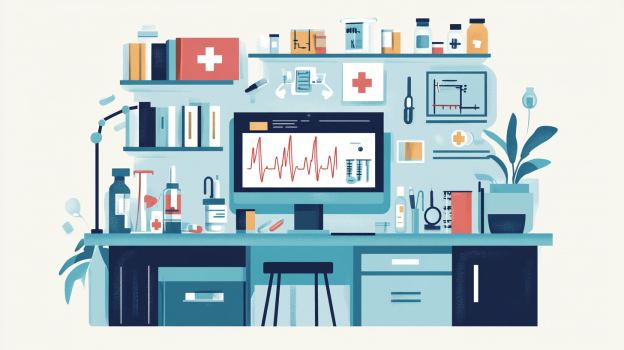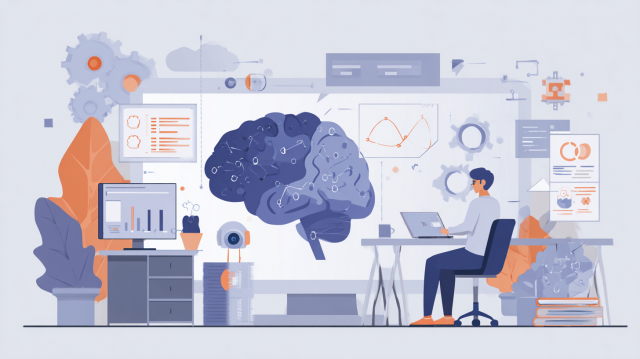
In recent years, the technology of AI (artificial intelligence) in the medical field has been advancing rapidly. AI is expected to be utilized in various areas such as image diagnosis, drug discovery, and medical data analysis, contributing to improved diagnostic accuracy and reduced burden on medical professionals. On the other hand, there are still many technical and ethical challenges regarding the implementation of medical AI, and careful discussions are required for its practical application.
This blog will introduce examples of the current use of medical AI, as well as provide a detailed explanation of the challenges it faces today. Furthermore, it will consider the future direction of development in response to these challenges and explore how medical AI will evolve.
- Table of Contents
1. Current State of Medical AI
While traditional medicine relied heavily on the experience and knowledge of specialists, recent years have seen the advancement of AI in supporting diagnosis and treatment, leading to efforts to improve the quality of healthcare. In particular, AI technology has evolved in areas such as imaging diagnosis, clinical support, drug discovery, and surgical assistance, and its application in medical settings has begun. Here, we will look at the utilization in each of these fields.
Utilization of AI in Image Diagnosis
AI contributes to the early detection of diseases and the improvement of diagnostic accuracy by analyzing CT, MRI, and X-ray images. For example, in the screening of lung cancer and breast cancer, AI plays a role in preventing oversight by detecting abnormal areas and assisting doctors in their diagnoses. In particular, cases have been reported where image analysis technology utilizing deep learning demonstrates diagnostic accuracy equal to or greater than that of specialists.
Reference (Our Past Blog): 3 Examples of Image Diagnosis Using Medical AI
Development of Clinical Support Systems
By analyzing electronic medical records and clinical data, AI plays a role in supporting physicians' medical practices. For example, systems have emerged that suggest optimal treatment methods based on patients' past medical histories and test results, contributing to the improvement of healthcare quality. Additionally, research has begun on implementing telemedicine and triage systems utilizing AI chatbots, which is expected to alleviate the burden on medical professionals.
Applications in Drug Discovery and New Drug Development
AI can analyze vast amounts of data and identify new drug candidates in a shorter time frame compared to before. Traditional drug discovery processes require over 10 years and enormous costs, but with the use of AI, the prediction of compound properties and the analysis of interactions with target proteins can be conducted rapidly. This has enabled rapid drug development, such as the development of the COVID-19 vaccine.
Reference: Generative AI Accelerates the Development of COVID-19 Treatments
Evolution of Surgical Assistance Technology
By maximizing the capabilities of AI, it is possible to assist not only in image diagnosis but also in surgical support. For example, in endoscopic surgery, there has been a challenge in visualizing organs, with a risk of damage that is not zero. The surgical support system "SurVis™" provides real-time recognition support and alerts for organs with a high risk of damage to the operating physician, helping to prevent misidentification and lack of confirmation of organs.
In this way, the applications of medical AI span a wide range of fields from diagnosis to treatment and drug development, holding the potential to improve the quality of healthcare.
2. Challenges in Medical AI
The use of AI in the medical field is gradually expanding in this way. On the other hand, there are many challenges that must be addressed when utilizing AI. Here, we will explain the challenges of medical AI.
Ensuring Data Quality and Quantity
The training of medical AI requires a large amount of high-quality training data. However, the medical data that serves as the basis for creating training data is strictly managed from the perspective of personal information protection, making data collection and sharing challenging. Additionally, there is a risk that biases in the data used for AI training may make it difficult to apply to specific patient groups. Furthermore, creating training data often requires specialized knowledge from doctors and healthcare professionals, and securing such knowledgeable resources is not easy. This poses a significant challenge in AI development, which requires a large volume of high-quality training data.
Regulatory and Ethical Issues
Medical AI directly impacts patients' lives and health, necessitating safety and reliability. Currently, in Japan, it is required to approve AI as a medical device under the regulations of the Ministry of Health, Labour and Welfare, but the complexity and time-consuming nature of the review process pose challenges. Additionally, the responsibility for diagnostic errors made by AI (whether it lies with AI developers, doctors, medical institutions, etc.) is unclear, and there is a need for legal development.
*Ministry of Health, Labour and WelfareRegarding the handling of medical devices using AI technology under the Pharmaceuticals and Medical Devices Actrefer to
Building a Collaborative System between Doctors and AI
AI should be utilized as an assistant to physicians, but it is necessary to create an environment where on-site doctors fully understand its effectiveness and can use it appropriately. In particular, for older physicians and healthcare professionals who are not familiar with IT, there can be high barriers to the introduction of AI, making education and training important.
Building Patient Trust
If the reliability of AI-based diagnosis and treatment is not established, patients may feel anxious about receiving care using AI. In particular, without explanations for AI's diagnostic results (why this conclusion was reached), it is difficult to gain the understanding of patients and doctors. Therefore, the development of "AI transparency" and "explainable AI (XAI*)" is being sought.
*XAI: An abbreviation for "Explainable AI," which is a general term for technologies aimed at understanding AI behavior from all perspectives and making it trustworthy.
By overcoming these challenges, medical AI has great potential to further develop and improve the quality of healthcare in the future.
Reference Blog: Advantages and Disadvantages of Medical AI
3. Future Prospects of Medical AI
Medical AI is expected to continue evolving and play a significant role in improving the quality of healthcare. Here, we will provide a detailed explanation of the future possibilities of medical AI.
Collaboration between AI and Healthcare Professionals
AI will not replace doctors but will evolve as a tool to support healthcare professionals. With the improvement in the accuracy of diagnostic assistance AI, faster and more accurate medical care will become possible. In particular, by assisting doctors in their diagnoses, AI will allow them to focus more on advanced treatments and patient interactions. Additionally, by optimizing treatment plans, AI is expected to promote the proper allocation of medical resources and personalized medicine.
Realization of Personalized Medicine
By utilizing AI, personalized medicine based on patients' genetic information and lifestyles can be realized, leading to more effective treatments. For example, in cancer treatment, AI can analyze the genetic mutations of individual patients' tumors and identify the most effective drugs. Additionally, AI contributes to early disease detection and prevention of worsening by monitoring patients' conditions in real-time and detecting abnormalities.
Promotion and Regulation of Medical AI
With the spread of medical AI, it is expected that regulations and guidelines will be developed to ensure the scope of AI application and safety. In particular, as the accuracy of diagnosis and treatment improves, discussions will deepen regarding the responsibilities and ethical issues related to medical practices involving AI. The formulation of international rules will also be an important issue, necessitating cooperation among regulatory authorities in various countries to advance standardization.
Integration with New Technologies
AI can enable more advanced medical support by combining with the latest technologies such as 5G, IoT, robotics, and 3D printing. For example, in robotic surgery assistance systems, AI can analyze surgical risks in real-time and assist doctors in their decision-making. Additionally, the development of AI diagnostic systems linked with wearable devices is expected to improve the accuracy of routine health management and remote medical care.
Promotion of Customized Care for Patients
AI technology analyzes patients' medical histories, genetic information, and lifestyle data to recommend optimal treatments and medications. This contributes to improving the quality of life for patients and also enhances the efficiency of the entire healthcare system. Furthermore, by enabling patients to understand their health status in real-time, it promotes preventive healthcare.
Future Developments
Medical AI can be applied in the fields of pre-disease and prevention, as well as rehabilitation and follow-up care, potentially leading to the development of services like digital comprehensive medical departments. Furthermore, with the advancement of online medical consultations utilizing the metaverse and the development of AI-driven automated medical assistants, access to healthcare is expected to improve dramatically. These technological innovations are believed to evolve healthcare into something more accessible and personalized.
4. Summary
As explained so far, with the evolution of AI technology, its application in the medical field will continue to expand, playing a role in improving the quality of healthcare in various areas such as diagnostic support, treatment planning, drug discovery, surgical assistance, and telemedicine.
The introduction of medical AI brings significant benefits such as improved diagnostic accuracy and reduced burden on physicians. However, there are also challenges that need to be addressed, including ensuring data quality, regulatory compliance, ethical issues, and gaining patient trust. In particular, securing high-quality training data and improving the explainability of AI-generated diagnostic results (XAI) will be important themes for future development.
Moreover, medical AI is a tool that complements healthcare professionals, and collaboration with doctors and nurses is essential. As technology evolves, the division of roles between AI and humans is expected to become clearer, enabling smoother healthcare delivery.
The future development of medical AI requires efforts from multiple perspectives, including not only technological development but also the establishment of regulations and ethics, as well as data standardization. To realize patient-centered healthcare and promote the safe and reliable use of AI, it is essential for healthcare professionals, researchers, companies, and government to collaborate and carefully advance this field.
Medical AI has the potential to significantly transform the future of healthcare. With upcoming technological innovations and their applications, better healthcare is anticipated.
Reference Blog: What is Medical AI? - Its History and Evolution
5. Medical Annotation Services in Human Sciences
●Extensive annotation experience in medical imaging
Our company has extensive experience in medical image annotation that requires skill transfer, such as surgical images and MRI images, which are of high difficulty and specialization. In addition to experienced project managers in medical image annotation projects, we also have many skilled workers, ensuring high-quality annotation even for projects that are complex, specialized, and require skill transfer.
●Support for physician supervision and annotations by physicians
It can be concerning to have only general workers perform all tasks. In such cases, we receive requests for supervision by a physician for certain check tasks. To meet these requests, we have further strengthened our physician supervision system, allowing us to handle more complex annotations. Additionally, even if you request annotations by physicians instead of general workers, our project managers will provide comprehensive management services, ensuring resource allocation, quality, and progress management.
Resource management without crowdsourcing
At Human Science, we do not use crowdsourcing. Instead, projects are handled by personnel who are contracted with us directly. Based on a solid understanding of each member's practical experience and their evaluations from previous projects, we form teams that can deliver maximum performance.
Secure room available on-site
Within our Shinjuku office at Human Science, we have secure rooms that meet ISMS standards. Therefore, we can guarantee security, even for projects that include highly confidential data. We consider the preservation of confidentiality to be extremely important for all projects. When working remotely as well, our information security management system has received high praise from clients, because not only do we implement hardware measures, we continuously provide security training to our personnel.
Support for not just annotation, but the creation and structuring of generative AI LLM datasets
In addition to labeling for data organization and annotation for identification-based AI systems, Human Science also supports the structuring of document data for generative AI and LLM RAG construction. Since our founding, our primary business has been in manual production, and we can leverage our deep knowledge of various document structures to provide you with optimal solutions.

 Text Annotation
Text Annotation Audio Annotation
Audio Annotation Image & Video Annotation
Image & Video Annotation Generative AI, LLM, RAG Data Structuring
Generative AI, LLM, RAG Data Structuring
 AI Model Development
AI Model Development In-House Support
In-House Support For the medical industry
For the medical industry For the automotive industry
For the automotive industry For the IT industry
For the IT industry




























































































